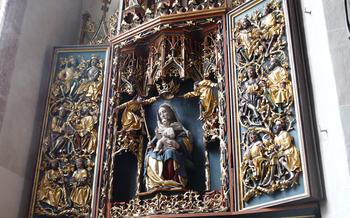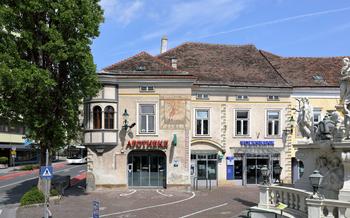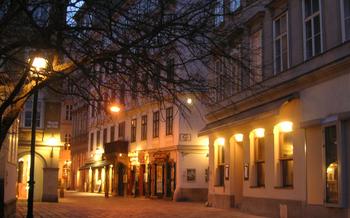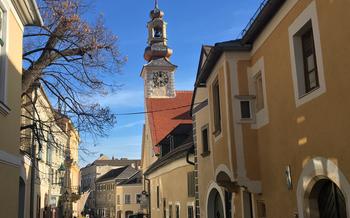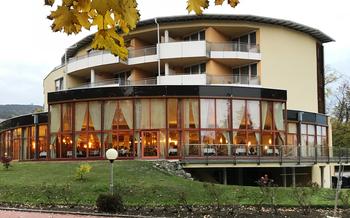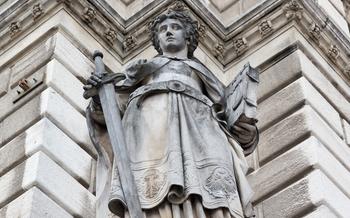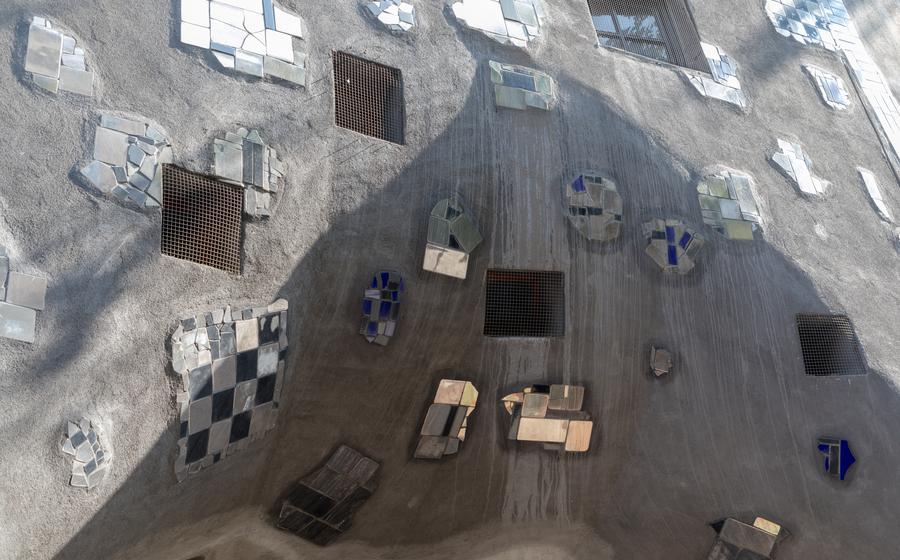
Hundertwasserhaus
- Hundertwasserhaus: A Unique Architectural Masterpiece
- Location and Accessibility
- Guided Tours and Self-Exploration
- Interior Exploration: The Hundertwasser Village
- Rooftop Terrace: Stunning City Views
- Hundertwasser's Environmental Message
- Integration of Art and Architecture
- Controversy and Criticism
- Global Recognition and Legacy
- Nearby Attractions and Activities
- Practical Tips for Visitors
- Events and Exhibitions at the Hundertwasserhaus
- Souvenirs and Merchandise
- Insider Tip:
- Insider Tip: Hidden Gems of the Hundertwasserhaus
Hundertwasserhaus: A Unique Architectural Masterpiece
The Hundertwasserhaus, an iconic landmark in Vienna, Austria, stands as a testament to the creative genius of Friedensreich Hundertwasser, an Austrian artist and architect renowned for his unconventional and vibrant style. Designed in collaboration with architect Josef Krawina, the Hundertwasserhaus is an architectural masterpiece that defies conventional norms, embodying Hundertwasser's belief in the harmonious integration of art and nature.
The building's striking facade is a symphony of colors and organic forms, featuring undulating lines, mosaic patterns, and vibrant hues. Inspired by the works of Friedensreich Hundertwasser, it is a unique and instantly recognizable structure that has become a symbol of Viennese creativity and innovation.
Its uneven floors, reminiscent of natural landscapes, and the incorporation of trees and plants into its structure create a sense of harmony between nature and architecture. The Hundertwasserhaus serves as a testament to the architect's commitment to blurring the boundaries between art and everyday life, transforming a residential building into a living work of art.
Location and Accessibility
The Hundertwasserhaus is situated in the heart of Vienna, Austria, at Kegelgasse 36-38, in the Landstraße district. Its convenient location makes it easily accessible by various means of transportation. To reach the building by public transport, visitors can take the U-Bahn (metro) and alight at the "Wien Mitte" station, which is just a short walk away. Alternatively, several bus lines stop nearby, including the 74A, 77A, and 79A. For those traveling by car, limited parking is available in the surrounding streets, but it's advisable to use public transportation or explore the area on foot to fully immerse themselves in the vibrant atmosphere of Vienna. The Hundertwasserhaus is strategically positioned in close proximity to other popular attractions, allowing visitors to explore multiple landmarks in a single day. The Belvedere Palace, renowned for its impressive art collection, is just a short walk away, while the Botanical Garden, with its diverse plant life, is also within easy reach.
Guided Tours and Self-Exploration
The Hundertwasserhaus offers guided tours in various languages, providing visitors with in-depth insights into the building's history, design, and significance. These tours typically cover highlights such as the colorful facades, uneven floors, and unique architectural features, while also shedding light on Hundertwasser's artistic vision and inspiration.
For those who prefer a more independent experience, self-guided exploration with an audio guide is another option. The audio guide provides a comprehensive commentary as visitors stroll through the building at their own pace, allowing them to focus on specific aspects that capture their interest.
Guided tours offer the advantage of having a knowledgeable guide who can answer questions and provide additional context, while self-guided exploration allows visitors to immerse themselves in the Hundertwasserhaus at their own leisure. Ultimately, the choice between a guided tour and self-exploration depends on individual preferences and interests.
Interior Exploration: The Hundertwasser Village
The Hundertwasserhaus is not just a residential building; it is also a vibrant cultural hub. Within its unique facade, you'll find a charming village of shops, galleries, and exhibition spaces. These spaces showcase the works of Friedensreich Hundertwasser and other contemporary artists, offering visitors an immersive experience into the world of Viennese creativity and innovation.
The highlight of the interior exploration is the "Kunst Haus Wien," a museum dedicated to Hundertwasser's life and work. Here, you can admire his paintings, prints, and architectural models, gaining insights into his creative process and inspirations. The museum also hosts temporary exhibitions, ensuring that there's always something new to discover for art enthusiasts.
But the Hundertwasserhaus is not just about art; it's also about creating a unique living environment. The building's quirky design extends to its interiors, with colorful corridors, uneven floors, and unique architectural details at every turn. Each apartment is one-of-a-kind, featuring Hundertwasser's signature style and reflecting his belief in the unity of art and architecture.
Accessibility is a key consideration within the Hundertwasserhaus. The building is wheelchair accessible, with ramps and elevators providing easy access to all levels. Visitors with disabilities can enjoy the same immersive experience as other visitors, exploring the shops, galleries, and museum without any barriers.
Rooftop Terrace: Stunning City Views
Ascend to the rooftop terrace of the Hundertwasserhaus to be greeted by a breathtaking panorama of Vienna. This elevated vantage point offers unparalleled views of the city's iconic landmarks, including the majestic St. Stephen's Cathedral, the opulent Belvedere Palace, and the verdant Prater Park. The terrace's unique perspective allows visitors to appreciate the harmonious blend of historical and modern architecture that characterizes Vienna.
The rooftop terrace is not only a visual feast but also an oasis of tranquility amidst the urban bustle. Surrounded by lush greenery and vibrant artwork, visitors can escape the city's hustle and bustle and immerse themselves in Hundertwasser's creative vision. Whether you're a photography enthusiast capturing the cityscape's beauty or a traveler seeking a moment of serenity, the rooftop terrace promises an unforgettable experience.
Accessibility and safety measures are meticulously considered to ensure a comfortable and enjoyable visit. The terrace is equipped with sturdy railings and non-slip surfaces, providing a safe environment for visitors of all ages. Additionally, elevators are available for those with limited mobility, ensuring that everyone can access this architectural gem.
Hundertwasser's Environmental Message
Friedensreich Hundertwasser, the visionary architect behind the Hundertwasserhaus, infused his creation with a powerful environmental message. His deep concern for the planet's well-being is woven into the very fabric of the building.
Hundertwasser believed in the harmonious coexistence of nature and architecture, a philosophy that manifests itself in the Hundertwasserhaus's unique design. The building's facade is adorned with lush vegetation, blurring the boundaries between the constructed and natural worlds. He incorporated trees and plants into the structure, creating a vibrant vertical garden that not only adds aesthetic appeal but also purifies the air.
Moreover, Hundertwasser's commitment to sustainability extended beyond aesthetics. He employed eco-friendly materials and techniques in the building's construction, such as recycled glass and locally sourced materials. The Hundertwasserhaus stands as a testament to his belief that architecture should not only serve human needs but also respect and protect the environment.
In an era where discussions on sustainability and climate change are more prevalent than ever, the Hundertwasserhaus stands as a poignant reminder of the urgent need to reconcile our built environment with the natural world. Hundertwasser's message of ecological harmony resonates deeply with contemporary concerns, inspiring architects and designers to embrace sustainable practices and create buildings that are both beautiful and environmentally responsible.
Integration of Art and Architecture
Friedensreich Hundertwasser believed in the inseparable unity of art and life. He viewed architecture not merely as a functional necessity but as a form of artistic expression. The Hundertwasserhaus exemplifies this philosophy, blurring the boundaries between art and architecture.
Hundertwasser incorporated numerous artistic elements into the building's design. The colorful facades, adorned with intricate patterns and mosaics, transform the building into a living canvas. The uneven floors, inspired by natural landscapes, add a dynamic and playful touch. The building's organic forms, reminiscent of Gaudi's architecture, further emphasize the fusion of art and nature.
This integration of art and architecture creates a truly unique and immersive experience for visitors. The Hundertwasserhaus invites them to engage with the building not just as a structure but as a work of art. It challenges traditional notions of architecture and encourages viewers to see the world through the eyes of an artist.
Hundertwasser's innovative approach has had a profound influence on modern architecture and design. His belief in the unity of art and life has inspired a generation of architects and designers to explore new possibilities and create buildings that are not only functional but also aesthetically pleasing and emotionally resonant.
Controversy and Criticism
When the Hundertwasserhaus was first unveiled, it was met with mixed reactions. Some hailed it as a groundbreaking masterpiece, while others criticized its unconventional design and questioned its functionality. Debates ensued over its aesthetic value, with some arguing that it was too colorful and chaotic, while others praised its originality and creativity. The building's uneven floors and unconventional layout also drew criticism from those who felt it was impractical and unsafe.
Hundertwasser himself was no stranger to controversy, and he often courted it with his provocative statements and designs. He defended the Hundertwasserhaus against its critics, arguing that it was a work of art that should be judged on its own terms, not by conventional standards of architecture. He believed that the building's unique features contributed to its charm and character, and that it was a symbol of his commitment to creating a more livable and sustainable world.
Over time, public perception of the Hundertwasserhaus has evolved. It has become a beloved landmark of Vienna, and is now widely recognized as a masterpiece of modern architecture. The building's unique design and Hundertwasser's environmental message have resonated with people around the world, and it has become a symbol of Viennese creativity and innovation.
Global Recognition and Legacy
The Hundertwasserhaus has garnered international acclaim for its unique design and innovative approach to architecture. Its reputation extends beyond Vienna, attracting visitors from around the world who come to marvel at this architectural masterpiece. The building's distinctive features have been widely recognized, earning it a place on the UNESCO World Heritage Tentative List.
The Hundertwasserhaus is considered a symbol of Viennese creativity and innovation, embodying the city's vibrant cultural scene. It stands as a testament to Friedensreich Hundertwasser's artistic genius and his commitment to creating a more harmonious relationship between architecture and nature. His vision has resonated with people worldwide, inspiring architects and designers to explore new possibilities in their work.
The legacy of the Hundertwasserhaus extends beyond its physical presence. It has become a symbol of the power of art to transform the urban landscape and create a more livable and sustainable world. Its enduring popularity demonstrates the enduring appeal of Hundertwasser's unique style and his belief in the unity of art and life.
Nearby Attractions and Activities
The Hundertwasserhaus is ideally situated within walking distance of several other notable attractions in Vienna. The Belvedere Palace, a magnificent Baroque complex, boasts an impressive art collection, including works by Gustav Klimt and Egon Schiele. Just a short stroll away, the Botanical Garden offers a tranquil oasis, showcasing a diverse array of plants from around the world.
For those seeking retail therapy, the Landstraßer Hauptstraße, a vibrant shopping street, is a must-visit. Here, you'll find a mix of international brands, local boutiques, and charming cafes. Whether you're looking to indulge in culinary delights, catch a movie, or simply soak up the vibrant atmosphere, Vienna has something to offer every visitor.
Practical Tips for Visitors
Plan Your Visit:
-
Timing: To avoid crowds, aim to visit the Hundertwasserhaus during weekdays or early mornings. weekends and holidays tend to be busier.
-
Photography Enthusiasts: If you're passionate about photography, consider bringing a wide-angle lens to capture the building's entirety. Tripod use is not permitted inside the building.
-
Accessibility: The Hundertwasserhaus is wheelchair accessible, with ramps and elevators provided for easy navigation.
-
Surrounding Area: Take some time to explore the surrounding Gegendviertel (neighborhood) for its charming cafes, boutiques, and art galleries.
Additional Tips:
-
Guided Tours: While self-exploration is possible, consider joining a guided tour for a deeper understanding of the building's history, architecture, and significance.
-
Souvenirs: The Hundertwasser Village within the building offers a range of souvenirs and merchandise inspired by Hundertwasser's artwork.
-
Local Cuisine: Indulge in Viennese cuisine at nearby restaurants, such as Gasthaus Wratschko or Restaurant Stefanie, for a taste of authentic Austrian flavors.
Events and Exhibitions at the Hundertwasserhaus
The Hundertwasserhaus is not just a static architectural masterpiece; it also serves as a vibrant cultural hub hosting a variety of events and exhibitions throughout the year. These events provide an opportunity for visitors to delve deeper into the world of Friedensreich Hundertwasser and his unique artistic vision.
Regular exhibitions showcase a diverse range of Hundertwasser's works, including paintings, drawings, prints, and architectural models. These exhibitions offer a comprehensive overview of his artistic journey and allow visitors to trace the evolution of his style over the years.
In addition to these permanent exhibitions, the Hundertwasserhaus also hosts special events and workshops that celebrate Hundertwasser's life and work. These events may include lectures by experts on Hundertwasser, guided tours with a focus on specific aspects of his art, or hands-on workshops where visitors can create their own Hundertwasser-inspired artworks.
Participating in these events and exhibitions is an enriching experience that allows visitors to gain a deeper understanding of Hundertwasser's artistic philosophy and creative process. It's an opportunity to engage with his work on a personal level and to discover new facets of his genius.
So, if you happen to be in Vienna during one of these events, be sure to check the Hundertwasserhaus's website or contact the information desk for details. It's a chance to immerse yourself in the world of this extraordinary artist and to experience his creative spirit firsthand.
Souvenirs and Merchandise
At the Hundertwasserhaus, you'll find a treasure trove of souvenirs and merchandise inspired by the artist's unique style. Within the building and in the surrounding area, you'll discover shops offering a wide range of items to commemorate your visit.
From postcards and posters featuring Hundertwasser's iconic designs to replicas of his famous paintings, there's something for every taste and budget. You'll also find an array of unique gifts and keepsakes, such as colorful ceramics, jewelry, and textiles.
Whether you're looking for a small token to remind you of your time at the Hundertwasserhaus or a special gift for a loved one, you're sure to find the perfect item among the many offerings available.
Insider Tip:
Don't miss the hidden gem of the Hundertwasserhaus gift shop, located in the inner courtyard. This charming boutique offers a curated selection of unique souvenirs and merchandise, including limited-edition prints, hand-painted ceramics, and exclusive Hundertwasser-designed items.
Insider Tip: Hidden Gems of the Hundertwasserhaus
Beyond the captivating facade and iconic design, the Hundertwasserhaus holds hidden gems that reveal even more of the artist's creativity and vision.
Venture into the inner courtyard, where a hidden world awaits. Surrounded by lush greenery, mosaic-covered walls, and whimsical sculptures, this serene space offers a tranquil escape from the city's hustle and bustle.
Discover the secret garden, a secluded oasis nestled within the building's complex. With its colorful tiles, vibrant plants, and a serene atmosphere, this hidden gem invites you to pause, reflect, and appreciate the beauty of nature amidst the urban landscape.
Don't miss the unique architectural details that often go unnoticed by visitors. From the intricate mosaic patterns on the walls to the quirky window designs and the sloping floors, each element of the Hundertwasserhaus tells a story and reflects the artist's boundless imagination.
Take your time to explore these hidden corners and uncover the secrets that make the Hundertwasserhaus not just a building but a living, breathing work of art.
